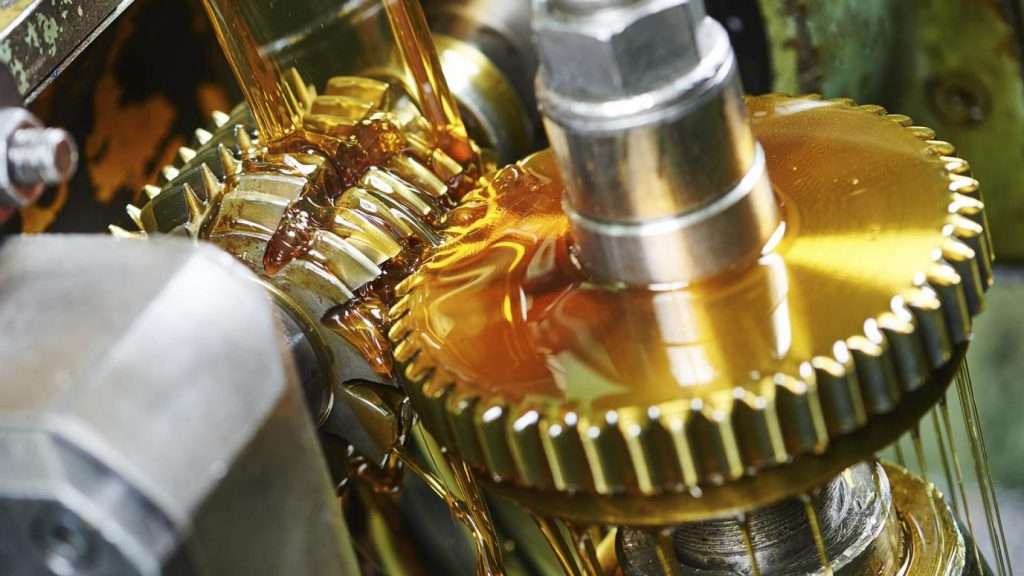Tips for Choosing Right Gear Oil Lubricant
Overview: Gear Oil
Gear oils are designed to protect gears, bearings, and seals in all types of enclosed gear drive with circulation or splash lubrication systems. They are also formulated for outstanding extreme-pressure characteristics, varying temperatures, and load-carrying properties in a broad range of industrial and automobile equipment.
Choosing the right gear oil can help provide slip-free power transmission even at high speed and eliminate pitting from forming in the contact region within the mechanisms of the respective machine.
When selecting lubricants for the right gear oil, numerous factors must be considered beyond simply selecting a product from the maintenance manual, such as product availability, operating conditions, the preferred lubricant brand, and product consolidation efforts. Proper lubricant selection is a cornerstone of any excellent lubrication program. Therefore when it comes to maintaining your machine’s gearbox it is crucial that the gear oil you choose to covers all the required parameters of the machine.
Factors That Define The Right Gear Oil For Application
The following criteria have to be followed for the best possible results when it comes to choosing the right gear oil. Viscosity, Additives and Base oil type.
Viscosity
The viscosity for a gear lubricant is primarily chosen to provide the desired film thickness between interacting surfaces at a given speed and load.
Choosing an appropriate viscosity grade is usually as simple as finding the recommendation in a component’s maintenance manual. Therefore, it is important to understand the methods for viscosity selection and the factors that affect the requirement.
The viscosity of the oil makes sure that all the mechanism inside the machinery is properly lubed and oil flows throw every part and component and there is no friction among the metals and thus the wear and tear are avoided.
Additives
The additive package used in the lubricant will determine the lubricant’s general category and affects various key performance properties under operating conditions.
They are organic or inorganic compounds dissolved or suspended as solids in oil. They typically range between 0.1 to 30 percent of the oil volume, depending on the machine. Enhance existing base oil properties with antioxidants, corrosion inhibitors, anti-foam agents, and emulsifying agents.
Suppress undesirable base oil properties and impart new properties to base oils with extreme pressure (EP) additives, detergents, and so on.
Base Oil Type
The type of base oil used should be determined by the operating conditions, gear type, and other factors.
There are two basic oil types, mineral and synthetic.
High-quality mineral base oils perform well in most applications. In fact, mineral base oils typically have higher pressure-viscosity coefficients than common synthetics, allowing for greater film thickness at a given operating viscosity. There are, however, situations where synthetic base oils are preferable.
Many synthetic base stocks have a greater inherent resistance to oxidation and thermal degradation making them preferable for applications with high operating temperatures and, in some cases, allowing for extended service intervals.
Additionally, synthetics perform better in machines subjected to low ambient temperatures due to their high viscosity index and low pour points.
Mosil's Gear Oil range
GEARLUBE PAG- 150s Gear Oil is a water-insoluble polyalkylene glycol based synthetic gear oil formulated with latest additive technology with friction modifiers to provide high performance and long life. Owing to its high Viscosity Index, excellent resistance to thermal degradation and superior thermal conductivity, the oil has good viscosity-temperature relations thereby offering excellent performance at high temperature. In addition, it has got anti-foaming demulsibility and E.P. properties for heavy duty applications.
AREA OF APPLICATION- Enclosed Gear drives, Transmission chains, Heavily loaded low speed antifriction bearing, Centralized lubrication systems. As a running-in-oil for OEMs.
Can also be used for Industrial bearings (journal and rolling contact), drives for conveyors, agitators, dryers, mixers, pumps etc.
BENEFITS-
- Resists Micropitting, provides EP & wear protection to gears, bearings etc
- Resists sludge formation leading to outstanding system cleanliness
- Very good oxidation resistance for long drain interval
- Good demulsibility for easy water removal
| CHARACTERISTICS | TYPICAL VALUES |
|---|---|
| Appearance | Clear |
| Color | Water White to Pale Yellow |
| Kinematic Viscosity @ 40°C | 135 – 165 |
| Viscosity Index | 202 (typical) |
| Flash Point °C (COC) | 220°C (typical) |
| Copper Strip Corrosion | ASTM 1a |
| Density @ 15° C | 1.00 ± 0.05 |
| Pour Point °C, ASTM D – 97 | -30 (max) |
| 4 Ball Weld Scar (mm) ASTM D – 2266 | 0.4 (max) |
| FZG Scuffing, Fail Stage, (A/8.3/90) | 12 + |
| Rust Protection, Distilled Water, ASTM D – 665 | Pass |
GEARLUBE PAG – 220s Gear Oil is a water-insoluble polyalkylene glycol based synthetic gear oil formulated with latest additive technology with friction modifiers to provide high performance and long life. Owing to its high Viscosity Index, excellent resistance to thermal degradation and superior thermal conductivity, the oil has good viscosity-temperature relations thereby offering excellent performance at high temperature. In addition, it has got anti-foaming demulsibility and E.P. properties for heavy duty applications.
AREA OF APPLICATION- Enclosed Gear drives, Transmission chains, Heavily loaded low-speed antifriction bearing, Centralized lubrication systems. As a running-in-oil for OEMs.
Can also be used for Industrial bearings (journal and rolling contact), drives for conveyors, agitators, dryers, mixers, pumps etc.
BENEFITS
- Resists Micropitting, provides EP & wear protection to gears, bearings etc
- Resists sludge formation leading to outstanding system cleanliness
- Very good oxidation resistance for long drain interval
- Good demulsibility for easy water removal
- Lead-Free
| CHARACTERISTICS | TYPICAL VALUES |
|---|---|
| Appearance | Clear |
| Color | Water White to Pale Yellow |
| Kinematic Viscosity @ 40°C | 198 – 242 |
| Viscosity Index | 213 (typical) |
| Flash Point °C (COC) | 228°C(min) |
| Copper Strip Corrosion | ASTM 1a |
| Density @ 15° C | 1.00 ± 0.05 |
| Pour Point °C, ASTM D – 97 | -30 (max) |
| 4 Ball Weld Scar (mm) ASTM D – 2266 | 0.4 (max) |
| FZG Scuffing, Fail Stage, (A/8.3/90) | 12 + |
| Rust Protection, Distilled Water, ASTM D – 665 | Pass |
Mosil Gearlube SP- 220s Gear Oil is a fully synthetic gear oil formulated from a carefully selected blend of Synthetic Hydrocarbon Base stocks. An inherently high Viscosity Index (VI) extends the operating temperature range at both the ends. The oil is further fortified with a synergistic blend of various additives like antiwear, EP etc. apart from the proprietary friction modifier additive of MOSIL.
AREA OF APPLICATION- Enclosed Gear drives, Transmission chains, Heavily loaded low speed antifriction bearing, Centralized lubrication systems. As a running-in-oil for OEMs. Heavy Duty Earthmoving and Excavating equipment.
BENEFITS
- Extends drain intervals
- Reduces wear and tear
- Reduces power consumption
- Chemically inert
| CHARACTERISTICS | TYPICAL VALUES |
|---|---|
| Appearance | Clear |
| Color | Pale Yellow to Brown |
| Kinematic Viscosity @ 40°C | 198 – 242 |
| Kinematic Viscosity @ 100°C | 20 – 30 |
| Viscosity Index | 150 (typical) |
| Flash Point°C (COC) | 220°C (min) |
| Copper Strip Corrosion | ASTM 1a |
| 4 Ball Wear Scar (mm) | 0.25 (max) |
| Carbon Residue Conradson % wt. | 0.7 (typical) |
| Density @ 15° C | 0.85 ± 0.05 |
| FZG Micropitting Fail Stage (FVA Proc No 54) | 10 |
Gearlube SP- 150e Gear oil series are specialty gear oils formulated with highly refined mineral oil along with latest additive technology with friction modifiers to provide high performance and long service life due to lower sludge formation. It contains sulphur – phosphorus chemistry of EP additives that provides high load carrying ability and wear protection.
AREA OF APPLICATION- Enclosed Gear drives, Transmission chains, Heavily loaded low speed antifriction bearing, Centralized lubrication systems. As a running-in-oil for OEMs.
Can also be used for Industrial bearings (journal and rolling contact), drives for conveyors, agitators, dryers, mixers, pumps etc.
BENEFITS
- Resists Micropitting, provides EP wear protection to gears, bearings etc
- Resists sludge formation leading to outstanding system cleanliness
- Very good oxidation resistance for long drain interval
- Very good demulsibility for easy water removal
- Lead-Free
| CHARACTERISTICS | TYPICAL VALUES |
|---|---|
| Appearance | Clear |
| Color | Yellow to Dark Brown |
| Kinematic Viscosity @ 40°C | 152.8 |
| Kinematic Viscosity @ 100°C | 14.81 |
| Viscosity Index | 96 |
| Flash Point°C (COC) | 230°C |
| Copper Strip Corrosion | 1a |
| Density @ 15° C | 0.9015 |
| FZG Micropitting Fail Stage A/8.3/90 | 12+ |
| Pour Point | -18 |
To view and explore more lubricant products for gearbox, you can visit-Gearbox Lubrication page













